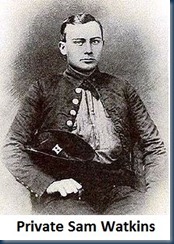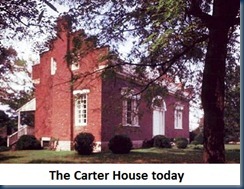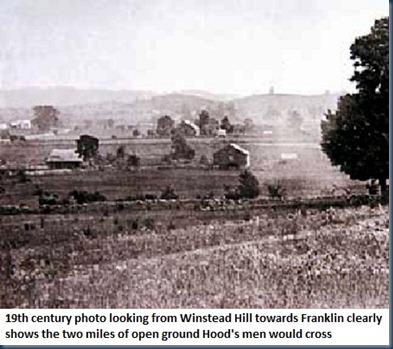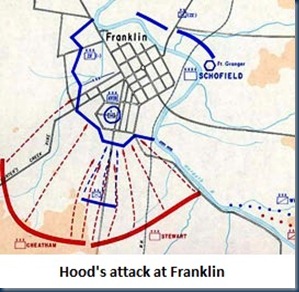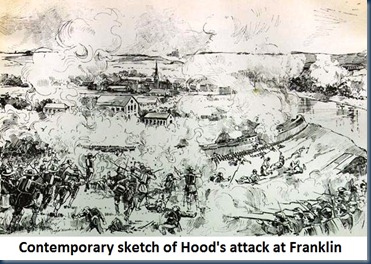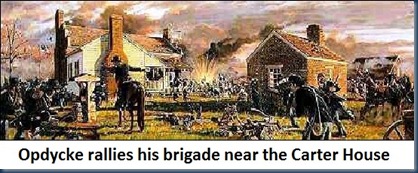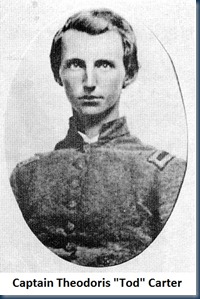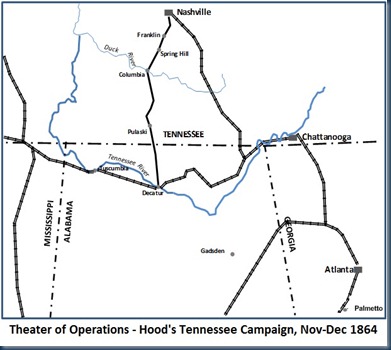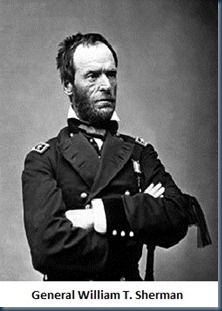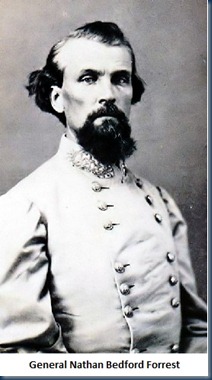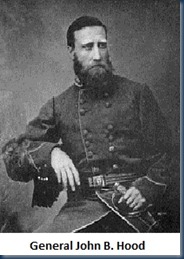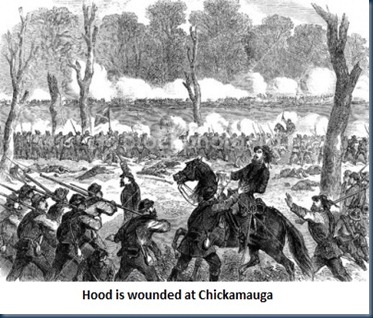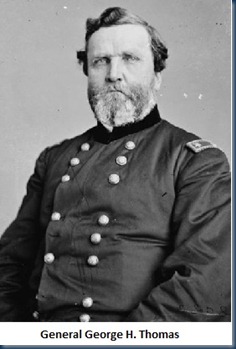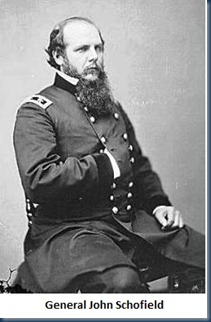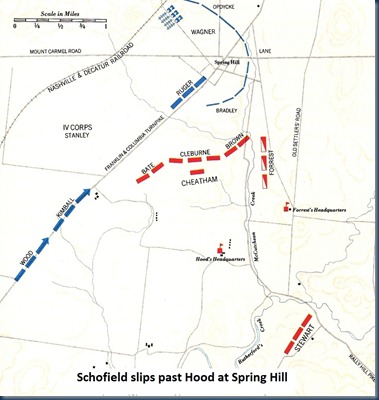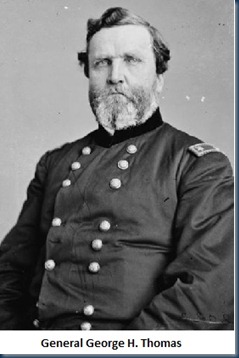 While John Schofield and John Hood had been playing out their own drama on the pike to Nashville, George Thomas had been a waging a three-front war of his own. First, he had been in constant contact with Schofield, urging him on and providing what little support he could. He was terribly anxious to get IV and XXIII Corps back to Nashville, and feared that Hood might, indeed, succeed in nabbing Schofield before he could escape. Therefore, Schofield’s dispatch from Franklin was a very welcome sight.
While John Schofield and John Hood had been playing out their own drama on the pike to Nashville, George Thomas had been a waging a three-front war of his own. First, he had been in constant contact with Schofield, urging him on and providing what little support he could. He was terribly anxious to get IV and XXIII Corps back to Nashville, and feared that Hood might, indeed, succeed in nabbing Schofield before he could escape. Therefore, Schofield’s dispatch from Franklin was a very welcome sight.
FRANKLIN, November 30, 1864--7.10 p.m.
Major-General THOMAS,
Nashville:
The enemy made a heavy and persistent attack with about two corps, commencing at 4 p.m. and lasting until after dark. He was repulsed at all points, with very heavy loss, probably 5,000 or 6,000 men. Our loss is probably not more than one-tenth that number. We have captured about 1,000 prisoners, including one brigadier-general. Your dispatch of this p.m. is received. I had already given the orders you direct, and am now executing them.
J. M. SCHOFIELD, Major-General.
By late afternoon on December 1, Schofield’s command marched into the defenses of Nashville, helping Thomas with his second problem, that of forming an army of sufficient size and strength to overwhelm Hood and the Army of Tennessee. Ever since Sherman had assigned him the duty of protecting the Union rear in Tennessee, Thomas had been waging a continual campaign to find men and material, and organize his new army. The struggle had not been an easy one. General Smith’s XVI Corps had been ordered east to Nashville from Missouri in mid-November, but had struggled against the weather, first in the form of torrential rains and then early snows in Missouri. They eventually made it to St. Louis on November 24, where they boarded steamers for the final leg of the journey up the Mississippi to the Ohio and then down the Cumberland River to Nashville.
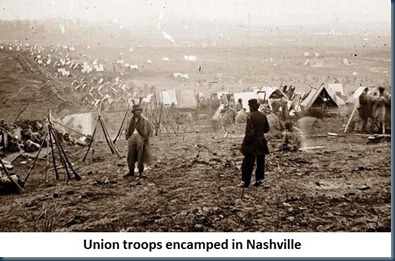 However, by November 29, they had not arrived and there was no word on their status. Thomas had recently lost nearly 15,000 veteran troops to enlistment expiration and, with only about 5,000 men inside the defenses of Nashville, he was understandably anxious to see Smith’s 12,000 men arrive. In the meantime, he began arming his cooks and quartermasters and was even given authority by the Secretary of War, Edward Stanton, to “to call upon the Governor of Indiana and of any other Western State for militia.” Therefore, Thomas telegraphed the garrison commander at Clarksville, further up the Cumberland, on November 29, asking if there had been any signs of Smith’s transports. Luckily, the Union commander there replied, “The last one of eleven transports, with troops, and two gun-boats have just passed up.”
However, by November 29, they had not arrived and there was no word on their status. Thomas had recently lost nearly 15,000 veteran troops to enlistment expiration and, with only about 5,000 men inside the defenses of Nashville, he was understandably anxious to see Smith’s 12,000 men arrive. In the meantime, he began arming his cooks and quartermasters and was even given authority by the Secretary of War, Edward Stanton, to “to call upon the Governor of Indiana and of any other Western State for militia.” Therefore, Thomas telegraphed the garrison commander at Clarksville, further up the Cumberland, on November 29, asking if there had been any signs of Smith’s transports. Luckily, the Union commander there replied, “The last one of eleven transports, with troops, and two gun-boats have just passed up.”
Just before Schofield and his corps arrived, the ships carrying Smith’s men docked in Nashville. That evening, another group of reinforcements, a provisional division and two brigades of black soldiers, arrived in Nashville under the command of General James Steedman. Now, with nearly 50,000 men under his command, Thomas felt better about his situation. However, most of the new troops were raw and inexperienced, and Thomas needed to get this new army organized to fight. Plus, there was the issue of his cavalry. If he were to take on John Hood, he wanted a cavalry force capable of handling the legendary Forrest. He had enough men, with about 15,000 troopers, but mounts were a serious issue. Many of his cavalry did not have horses and, upon arriving in Nashville, Wilson’s were about played out. So, Thomas set about trying to find sufficient horseflesh to mount his cavalrymen, a process that would take several days to complete. In the meantime, John Hood and his army arrived outside Nashville in the early afternoon of December 2, and began to dig in just south of the city.
However, the toughest battle George Thomas would fight was the one he fought with his own chain of command. As I mentioned in the first part of this series, Ulysses Grant, ever the bold, aggressive, audacious soldier, considered the deliberate Thomas to be a “plodder,” a trait he could not abide. As Thomas labored to bring his command together, Grant tried to give him some room, but Grant himself was besieged by a constant stream of urgent dispatches from Washington demanding that Thomas take to the field. At his end, what George Thomas saw was a three-headed monster spewing messages urging him to take the field. That monster was a product of the command structure Lincoln and Grant had carved out together and, while it was very effective for the most part, here it created command chaos.
 In the Union command system at the end of the war, Grant was General-in-Chief of all Union ground forces, and he worked from the field, accompanying George Meade and the Army of the Potomac as they campaigned against Lee. Meanwhile, in Washington, Grant’s predecessor, General Henry Halleck, functioned as his Chief of Staff. Halleck’s job was to interpret Grant’s communications for President Lincoln and provide the president’s views to Grant. The third element in this mix was Edward Stanton, the Secretary of War. Stanton seems to have operated somewhat independently, communicating directly with Grant at times, through Halleck on occasion and even directly with Thomas now and then. But no matter who the dispatches came from, the message to Thomas was always consistent: attack Hood
In the Union command system at the end of the war, Grant was General-in-Chief of all Union ground forces, and he worked from the field, accompanying George Meade and the Army of the Potomac as they campaigned against Lee. Meanwhile, in Washington, Grant’s predecessor, General Henry Halleck, functioned as his Chief of Staff. Halleck’s job was to interpret Grant’s communications for President Lincoln and provide the president’s views to Grant. The third element in this mix was Edward Stanton, the Secretary of War. Stanton seems to have operated somewhat independently, communicating directly with Grant at times, through Halleck on occasion and even directly with Thomas now and then. But no matter who the dispatches came from, the message to Thomas was always consistent: attack Hood  now.
now.
The fear, particularly among Lincoln and Stanton, was that Thomas would prove to be another general who organized but did not fight. They had visions of John Hood bypassing Nashville, crossing the Cumberland River, invading Kentucky, and moving on to the Ohio River, all while George Thomas remained safely behind his fortifications. The day after Thomas’ reinforcements arrived, Stanton telegraphed Grant:
WAR DEPARTMENT,
Washington, December 2, 1864--10.30 a.m.Lieutenant-General GRANT,
City Point:The President feels solicitous about the disposition of General Thomas to lay in fortifications for an indefinite period "until Wilson gets equipments.” This looks like the McClellan and Rosecrans strategy of do nothing and let the rebels raid the country. The President wishes you to consider the matter.
E. M. STANTON, Secretary of War.
Grant told Stanton that he would order Thomas to get moving and sent two telegrams to Thomas:
CITY POINT, VA., December 2, 1864--11 a.m.
Major-General THOMAS,
Nashville, Tenn.:If Hood is permitted to remain quietly about Nashville, you will lose all the road back to Chattanooga, and possibly have to abandon the line of the Tennessee. Should he attack you it is all well, but if he does not you should attack him before he fortifies. Arm and put in the trenches your quartermaster employés, citizens, &c.
U.S. GRANT, Lieutenant-General.
CITY POINT, VA., December 2, 1864--1.30 p.m.
Major-General THOMAS,
Nashville, Tenn. :With your citizen employés armed, you can move out of Nashville with all your army and force the enemy to retire or fight upon ground of your own choosing. After the repulse of Hood at Franklin, it looks to me that instead of fal1ing back to Nashville, we should have taken the offensive against the enemy where he was. At this distance, however, I may err as to the best method of dealing with the enemy. You will now suffer incalculable injury upon your railroads, if Hood is not speedily disposed of. Put forth, therefore, every possible exertion to attain this end. Should you get him to retreating, give him no peace.
U. S. GRANT, Lieutenant-General.
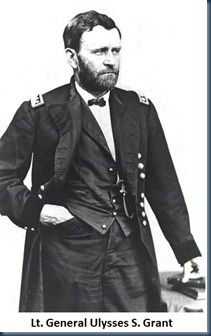 Thomas responded prudently, sending dispatches to both Halleck in Washington and Grant at City Point. He carefully stated the situation trying to help them see that he was close to being ready, but that he needed time, hopefully only two or three days. He reminded Grant that the two corps Schofield provided were the weakest in Sherman’s army and that he needed to get the mix of men from Schofield, Smith, and Steedman organized into a command capable of fighting. He also told Halleck that, essentially, Hood was not going anywhere. Thomas had wisely ordered the Navy’s gunboats to constantly patrol the Cumberland, watching for any signs of a crossing, which they were to oppose vigorously, if discovered.
Thomas responded prudently, sending dispatches to both Halleck in Washington and Grant at City Point. He carefully stated the situation trying to help them see that he was close to being ready, but that he needed time, hopefully only two or three days. He reminded Grant that the two corps Schofield provided were the weakest in Sherman’s army and that he needed to get the mix of men from Schofield, Smith, and Steedman organized into a command capable of fighting. He also told Halleck that, essentially, Hood was not going anywhere. Thomas had wisely ordered the Navy’s gunboats to constantly patrol the Cumberland, watching for any signs of a crossing, which they were to oppose vigorously, if discovered.
What no one seemed to see is that Thomas had the situation well in-hand. He was not shrinking from a fight, as Stanton and Lincoln feared. Rather, he was ensuring that he could execute the maximum combat power possible against an enemy who was exactly where he wanted him. By allowing Hood to deploy outside the city, Thomas had permitted his opponent, now outnumbered and operating on short rations, to further extend and expose his lines of communication and supply. Further, Thomas had no intention of remaining on the defensive. Once he was ready, he fully intended to strike Hood and strike him hard. But this was apparently lost on his chain of command, who continued to see only needless delay.
On December 5, Grant telegraphed Thomas, urging him to take the offensive, saying, “It seems to me whilst you should be getting up your cavalry as rapidly as possible to look after Forrest, Hood should be attacked where he is. Time strengthens him, in all probability, as much as it does you.” Thomas did not reply, causing Grant to send an even more strident dispatch the next day:
CITY POINT, VA., December 6, 1864--4 p.m.
Maj. Gen. G. H. THOMAS,
Nashville, Tenn.:Attack Hood at once, and wait no longer for a remount of your cavalry. There is great danger of delay resulting in a campaign back to the Ohio River.
U.S. GRANT, Lieutenant-General.
Thomas replied, saying, “Your telegram of 4 p.m. this day is just received. I will make the necessary dispositions and attack Hood at once, agreeably to your order, though I believe it will be hazardous with the small force of cavalry now at my service.” The next afternoon, December 7, Grant’s impatience began to get the better of him, and he wrote Secretary Stanton that, if Thomas did not attack immediately, he would order Schofield to assume overall command, reassigning Thomas to be his subordinate. Grant then wrote Halleck on December 8, saying, “If Thomas has not struck yet, he ought to be ordered to hand over his command to Schofield. There is no better man to repel an attack than Thomas, but I fear he is too cautious to ever take the initiative.” George Thomas might be steadily preparing to win a military battle in the field, but he was rapidly losing the political battle east of the Appalachians.
 When one reads Grant’s communications with Washington, you can see that he still believed Thomas was the best man for the job. However, at the same time, the general-in-chief seemed to feel that he was running short of not just patience, but also political capital. That night, Halleck wrote to him that, if Grant wanted Thomas removed, no one would interfere. Grant replied saying, “I want General Thomas reminded of the importance of immediate action. I sent him a dispatch this evening which will probably urge him on. I would not say relieve him until I hear further from him.”
When one reads Grant’s communications with Washington, you can see that he still believed Thomas was the best man for the job. However, at the same time, the general-in-chief seemed to feel that he was running short of not just patience, but also political capital. That night, Halleck wrote to him that, if Grant wanted Thomas removed, no one would interfere. Grant replied saying, “I want General Thomas reminded of the importance of immediate action. I sent him a dispatch this evening which will probably urge him on. I would not say relieve him until I hear further from him.”
When nothing was heard from Thomas the next morning, Grant asked that all preparations be made to relieve Thomas of his duties. The Adjutant General wrote the following message:
WAR DEPT., ADJT. GENERAL'S OFFICE,
Washington, D.C., December 9, 1864.In accordance with the following dispatch from Lieutenant-General Grant, viz--
Please telegraph order relieving him (General Thomas) at once and placing Schofield in command. Thomas should be directed to turn over all dispatches received since the battle of Franklin to Schofield.
U. S. GRANT, Lieutenant-General.
The President orders:
I. That Maj. Gen. J. M. Schofield assume command of all troops in the Departments of the Cumberland, the Ohio, and the Tennessee.
II. That Maj. Gen. George H. Thomas report to General Schofield for duty and turn over to him all orders and dispatches received by him, as specified above.
By order of the Secretary of War:
But, the message was not sent immediately. Halleck wrote directly to Thomas, again urging him to move against Hood and adding that General Grant was very dissatisfied with his performance. Thomas replied, again stating his need for horses, but he added news of a new development: a major ice storm had struck Nashville on the morning of December 9 and there was no possibility of an attack, as the ground was totally coated with ice and more was coming down. He then telegraphed Grant, telling him that, “Major-General Halleck informs me that you are very much dissatisfied with my delay in attacking. I can only say I have done all in my power to prepare, and if you should deem it necessary to relieve me I shall submit without a murmur.” In fact, two hours before Thomas wrote to Grant, the commanding general had issued orders to relieve Thomas of command.
However, when he saw Thomas’ latest dispatch, he asked that the orders to fire Thomas be held back and dashed a telegram off to Thomas in Nashville:
CITY POINT, VA., December 9, 1864--7.30 p.m.
Major-General THOMAS,
Nashville, Tenn.:Your dispatch of 1 p.m. received. I have as much confidence in your conducting a battle rightly as I have in any other officer; but it has seemed to me that you have been slow, and I have had no explanation of affairs to convince me otherwise. Receiving your dispatch of 2 p.m. from General Halleck, before I did the one to me, I telegraphed to suspend the order relieving you until we should hear further. I hope most sincerely that there will be no necessity of repeating the orders, and that the facts will show that you have been right all the time.
U. S. GRANT, Lieutenant-General.
Later that night, Halleck and Grant again exchanged telegrams over the matter of replacing Thomas. Once more, Grant expressed his frustration, but also stated his confidence in Thomas, saying, “I am very unwilling to do injustice to an officer who has done as much good service as General Thomas has, however, and will, therefore, suspend the order relieving him until it is seen whether he will do anything.”
The ice storm eventually abated, but the temperatures were now so low every surface was coated in several inches of ice. There was no way a man could walk upright on even a level surface, much less an army move to the attack. When Thomas informed Halleck and Grant on December 11 that it was impossible to attack until a thaw took place, Grant again ordered him to attack without delay “for weather or re-enforcements.” But, again, Thomas deferred and Grant finally decided it was time to relieve his plodding general and to do so himself. He left City Point en route to Nashville via Washington. On December 14, as Grant traveled north to the capital, Thomas telegraphed Halleck that the ice was melting and that he would launch his attack the next morning.
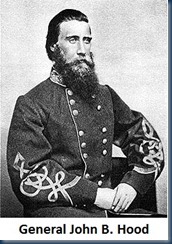 As George Thomas battled his own chain of command, John Hood and his army fought Mother Nature. Their entrenchments were about 10 miles south and southeast of Nashville. The right end of their lines stopped about a mile short of the Murfreesboro Turnpike, where Cheatham’s corps dug in. From there, the Confederate line ambled generally west and southwest, with Lee’s corps in the center, until it reached a point just short of the Hillsboro Turnpike. There, the line turned almost 90 degrees and ran south in parallel to the pike, where Stewart’s battered corps held the line. Hood only had enough men to cover about four miles and, even at that, his men were stretched dangerously thin. He had requested reinforcements, but none were on the way. Meanwhile, his men shivered in the cold, many with no shoes or even head gear. Unlike their Federal opponents, there were no warm tents, much less barracks. Instead, they dug holes in the frozen earth as best they could, lined them with twigs and leaves, and then huddled together, three and four men to a hole, trying to find warmth under threadbare blankets.
As George Thomas battled his own chain of command, John Hood and his army fought Mother Nature. Their entrenchments were about 10 miles south and southeast of Nashville. The right end of their lines stopped about a mile short of the Murfreesboro Turnpike, where Cheatham’s corps dug in. From there, the Confederate line ambled generally west and southwest, with Lee’s corps in the center, until it reached a point just short of the Hillsboro Turnpike. There, the line turned almost 90 degrees and ran south in parallel to the pike, where Stewart’s battered corps held the line. Hood only had enough men to cover about four miles and, even at that, his men were stretched dangerously thin. He had requested reinforcements, but none were on the way. Meanwhile, his men shivered in the cold, many with no shoes or even head gear. Unlike their Federal opponents, there were no warm tents, much less barracks. Instead, they dug holes in the frozen earth as best they could, lined them with twigs and leaves, and then huddled together, three and four men to a hole, trying to find warmth under threadbare blankets.
Hood’s plan was to withstand the coming Federal assault, smash it, and then launch a swift counterattack that would send the Union forces reeling from the city. Given that plan and the fact that the massive Union line overlapped his significantly, it is odd that, on December 7, Hood sent almost all of Forrest’s cavalry and one division of his precious infantry to perform what he later called “a reconnaissance in force” of nearby Murfreesboro. If Forrest thought he could take the Federal garrison there, he was to do so, perhaps in the hope that Thomas would weaken his force to stop Forrest. However, Forrest determined this was not feasible and, while he sent the infantry back to Hood, he remained near Murfreesboro. As a result, Hood would go into the fight against Thomas without his “eyes,” which he badly needed to cover his extremely vulnerable flanks.
When December 15 dawned, the sun struggled to burn through a blinding white fog that blanketed the hills around Nashville. The ground was muddy as a result of the melted ice, slowing Union units moving forward to prepare for the attack. The terrain between the Union fortifications and Hood’s line consisted primarily of open, rolling farmland, punctuated by numerous ridges and small knolls that rose 200 to 300 feet above the fields surrounding them. There was plenty of room for maneuver and clear fields of fire.
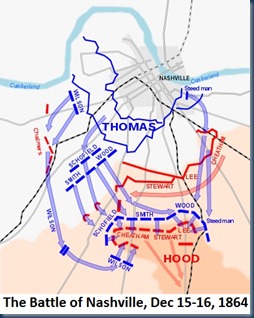 Thomas’ plan of attack called for a feint against Hood’s right, where Steedman’s command would attack Cheatham and try to hold him in place. Meanwhile, Smith’s XVI Corps and Wood’s IV Corps, supported by dismounted cavalry from Hatch’s division, would swing wide to the right and make an enveloping attack against Stewart on the Confederate left. Schofield and his XXIII Corps would be held in reserve and move forward to exploit any gains made by Smith and Wood.
Thomas’ plan of attack called for a feint against Hood’s right, where Steedman’s command would attack Cheatham and try to hold him in place. Meanwhile, Smith’s XVI Corps and Wood’s IV Corps, supported by dismounted cavalry from Hatch’s division, would swing wide to the right and make an enveloping attack against Stewart on the Confederate left. Schofield and his XXIII Corps would be held in reserve and move forward to exploit any gains made by Smith and Wood.
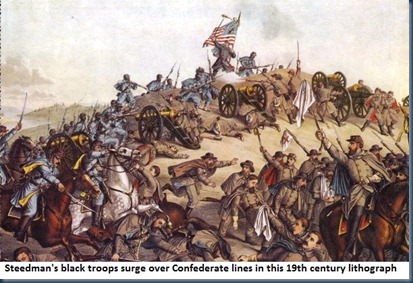 By 8:00 a.m., the fog began to lift and Steedman launched his attack against Hood’s right. While it was the first combat for his black brigades, they attacked with ferocity, climbing the hills where Cheatham was entrenched in the face of a murderous fire. They succeeded in capturing the first line of Confederate rifle pits, but then their attack bogged down. Still, they would hold this position and keep up a hot and continuous fire on Hood’s men. This had the desired affect: Hood believed that the main Union assault was being made on his right and Cheatham would be heavily engaged there for most of the day. While all this was happening, the real threat was steadily approach Hood’s left and, without Forrest’s cavalry to warn him, he never saw it coming.
By 8:00 a.m., the fog began to lift and Steedman launched his attack against Hood’s right. While it was the first combat for his black brigades, they attacked with ferocity, climbing the hills where Cheatham was entrenched in the face of a murderous fire. They succeeded in capturing the first line of Confederate rifle pits, but then their attack bogged down. Still, they would hold this position and keep up a hot and continuous fire on Hood’s men. This had the desired affect: Hood believed that the main Union assault was being made on his right and Cheatham would be heavily engaged there for most of the day. While all this was happening, the real threat was steadily approach Hood’s left and, without Forrest’s cavalry to warn him, he never saw it coming.
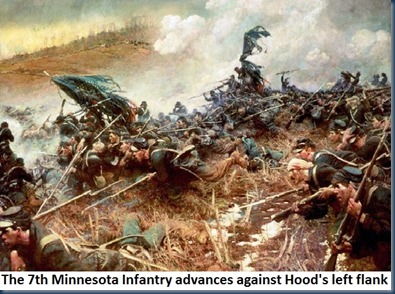 The IV and XVI Corps swept forward, knocking Stewart’s men off Montgomery Hill and then they swarmed over the artillery redoubts Hood had constructed near the Hillsboro Pike. At 1:00 p.m., Thomas committed Schofield’s Corps to the attack and sent all of Wilson’s cavalry to the right, in an attempt to cut off Hood’s escape routes. Thirty minutes later, the wave of blue-clad infantry crashed through the main Confederate fieldworks and broke the salient in the Southern line. Stewart’s men began a retreat to the southeast toward the Granny White Turnpike, and the entire Confederate left collapsed. The retreat was, however, not a panicked one, as most units fell back in good order. As the left moved back, Cheatham also began to retreat, as Federal units maintained a constant pressure.
The IV and XVI Corps swept forward, knocking Stewart’s men off Montgomery Hill and then they swarmed over the artillery redoubts Hood had constructed near the Hillsboro Pike. At 1:00 p.m., Thomas committed Schofield’s Corps to the attack and sent all of Wilson’s cavalry to the right, in an attempt to cut off Hood’s escape routes. Thirty minutes later, the wave of blue-clad infantry crashed through the main Confederate fieldworks and broke the salient in the Southern line. Stewart’s men began a retreat to the southeast toward the Granny White Turnpike, and the entire Confederate left collapsed. The retreat was, however, not a panicked one, as most units fell back in good order. As the left moved back, Cheatham also began to retreat, as Federal units maintained a constant pressure.
As darkness began to fall, Hood reorganized his line about two miles to the south and had his men dig in, his line now shrinking from four miles to only two. Luckily, Thomas’ attackers became disorganized by their success and the Union pursuit had to be halted for the night. Hood hoped to counterattack in the morning, while Thomas planned to continue the attack at first light. It would be a matter of who moved first.
Thomas decided to begin the next day with a massive artillery barrage, then execute another flanking attack on the Confederate left, while he simultaneously pushed hard against the Southern center and right. For his part, Hood rearranged his forces, placing Stewart’s men in the center with Lee on the right and Cheatham on the left. When December 16 dawned, Thomas would move first.
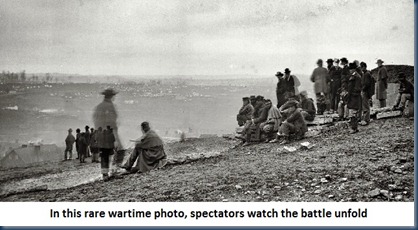 Union artillery opened up at 9:00 a.m., and continued firing for two hours. At 10:00 a.m., Steedman’s men assaulted the Confederate right, but could not make any gains against Lee’s corps, who stubbornly held their ground against repeated attacks. As these assaults continued, the Union artillery shifted their fire to Hood’s left against Cheatham’s corps. Because of their position, the Federal batteries were soon pouring a relentless barrage that enfiladed Cheatham’s line and, by 3:30 p.m., as XVI and XXIII Corps smashed into the Southern left, Cheatham’s infantry had essentially been neutralized as a fighting force. As Union infantry broke through the line, the entire Confederate left broke and the center would soon follow. This time, the retreat was not orderly, as men fled for their lives. Only Lee managed an orderly retreat and his fighting withdrawal probably saved Hood’s army from an even greater disaster.
Union artillery opened up at 9:00 a.m., and continued firing for two hours. At 10:00 a.m., Steedman’s men assaulted the Confederate right, but could not make any gains against Lee’s corps, who stubbornly held their ground against repeated attacks. As these assaults continued, the Union artillery shifted their fire to Hood’s left against Cheatham’s corps. Because of their position, the Federal batteries were soon pouring a relentless barrage that enfiladed Cheatham’s line and, by 3:30 p.m., as XVI and XXIII Corps smashed into the Southern left, Cheatham’s infantry had essentially been neutralized as a fighting force. As Union infantry broke through the line, the entire Confederate left broke and the center would soon follow. This time, the retreat was not orderly, as men fled for their lives. Only Lee managed an orderly retreat and his fighting withdrawal probably saved Hood’s army from an even greater disaster.
That night, Hood skillfully reorganized what was left of the Army of Tennessee and began a full retreat. The next morning, George Thomas would send Wilson’s cavalry in pursuit but, once again, the weather intervened. Wilson was slowed by the muddy roads, as well as an effective rear guard fight put up by Confederate cavalry and infantry. When Forrest rejoined Hood on December 18, pursuing Federal troops had no hope of closing in any further. When Hood finally crossed the Tennessee River on Christmas Day, the Union pursuit ended for good. Hood would withdraw to Tupelo, Mississippi and could only muster 15,000 men upon arrival there.
On January 13, John Hood tendered his resignation to President Davis, which was accepted. With that, a proud, passionate warrior became a part of history. As for his army, I will rely on the words of Sam Watkins:
The once proud Army of Tennessee had degenerated to a mob. We were pinched by hunger and cold. The rains, and sleet, and snow never ceased falling from the winter sky, while the winds pierced the old, ragged, gray-back Rebel soldier to his very marrow. The clothing of many were hanging around them in shreds of rags and tatters, while an old slouched bat covered their frozen ears. Some were on old, raw-boned horses, without saddles….Our country is gone, our cause is lost. "Actum est de Republica."
With the campaign concluded, the last major fighting in the Western Theater was finally at an end. The focus would now turn to the east, as Sherman’s army moved inexorably north up the coast, leaving a path of destruction through South Carolina. The final drama would be performed in Virginia and North Carolina, but the war’s outcome had already been determined in the West.

